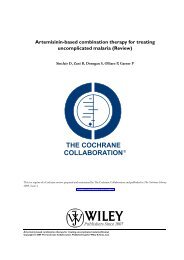Antiamoebic drugs for treating amoebic colitis - The Cochrane Library
Antiamoebic drugs for treating amoebic colitis - The Cochrane Library
Antiamoebic drugs for treating amoebic colitis - The Cochrane Library
You also want an ePaper? Increase the reach of your titles
YUMPU automatically turns print PDFs into web optimized ePapers that Google loves.
[Intervention Review]<br />
<strong>Anti<strong>amoebic</strong></strong> <strong>drugs</strong> <strong>for</strong> <strong>treating</strong> <strong>amoebic</strong> <strong>colitis</strong><br />
Maria Liza M Gonzales 1 , Leonila F Dans 2 , Elizabeth G Martinez 1<br />
1 Department of Pediatrics, College of Medicine-Philippine General Hospital, University of the Philippines, Manila, Philippines.<br />
2 Departments of Pediatrics and Clinical Epidemiology, Philippine General Hospital, University of the Philippines, Manila, Philippines<br />
Contact address: Maria Liza M Gonzales, Department of Pediatrics, College of Medicine-Philippine General Hospital, University of<br />
the Philippines, Taft Avenue, Manila, National Capital Region, 1000, Philippines. lizmgonzales@yahoo.com.<br />
Editorial group: <strong>Cochrane</strong> Infectious Diseases Group.<br />
Publication status and date: New, published in Issue 2, 2009.<br />
Review content assessed as up-to-date: 4 December 2008.<br />
Citation: Gonzales MLM, Dans LF, Martinez EG. <strong>Anti<strong>amoebic</strong></strong> <strong>drugs</strong> <strong>for</strong> <strong>treating</strong> <strong>amoebic</strong> <strong>colitis</strong>. <strong>Cochrane</strong> Database of Systematic<br />
Reviews 2009, Issue 2. Art. No.: CD006085. DOI: 10.1002/14651858.CD006085.pub2.<br />
Copyright © 2009 <strong>The</strong> <strong>Cochrane</strong> Collaboration. Published by John Wiley & Sons, Ltd.<br />
Background<br />
A B S T R A C T<br />
Entamoeba histolytica infection is common in developing countries, and up to 100,000 individuals with severe disease die every year.<br />
Adequate therapy <strong>for</strong> <strong>amoebic</strong> <strong>colitis</strong> is necessary to reduce the severity of illness, prevent development of complicated disease and<br />
extraintestinal spread, and decrease transmission.<br />
Objectives<br />
To evaluate anti<strong>amoebic</strong> <strong>drugs</strong> <strong>for</strong> <strong>treating</strong> <strong>amoebic</strong> <strong>colitis</strong>.<br />
Search strategy<br />
In September 2008, we searched the <strong>Cochrane</strong> Infectious Diseases Group Specialized Register, CENTRAL (2008, Issue 3), MEDLINE,<br />
EMBASE, LILACS, mRCT, and conference proceedings. We contacted individual researchers, organizations, and pharmaceutical<br />
companies, and checked reference lists.<br />
Selection criteria<br />
Randomized controlled trials of anti<strong>amoebic</strong> <strong>drugs</strong> given alone or in combination, compared with placebo or another anti<strong>amoebic</strong><br />
drug <strong>for</strong> <strong>treating</strong> adults and children diagnosed with <strong>amoebic</strong> <strong>colitis</strong>.<br />
Data collection and analysis<br />
Two authors independently assessed the eligibility and methodological quality of trials, and extracted and analysed the data. We<br />
calculated clinical and parasitological failure rates, relapse, and adverse events as risk ratios (RR) with 95% confidence intervals (CIs),<br />
using a random-effects model. We determined statistical heterogeneity and explored possible sources of heterogeneity using subgroup<br />
analyses. We carried out sensitivity analysis using trial quality to assess the robustness of the results.<br />
Main results<br />
Thirty-seven trials, enrolling 4487 participants, met the inclusion criteria. Only one trial used adequate methods <strong>for</strong> randomization<br />
and allocation concealment, was blinded, and analysed all randomized participants. Only one trial used a E. histolytica stool antigen<br />
test. Tinidazole reduced clinical failure compared with metronidazole (RR 0.28, 95% CI 0.15 to 0.51; 477 participants, eight trials)<br />
and was associated with fewer adverse events. Compared with metronidazole, combination therapy resulted in fewer parasitological<br />
failures (RR 0.36, 95% CI 0.15 to 0.86; 720 participants, 3 trials).<br />
<strong>Anti<strong>amoebic</strong></strong> <strong>drugs</strong> <strong>for</strong> <strong>treating</strong> <strong>amoebic</strong> <strong>colitis</strong> (Review)<br />
Copyright © 2009 <strong>The</strong> <strong>Cochrane</strong> Collaboration. Published by John Wiley & Sons, Ltd.<br />
1








